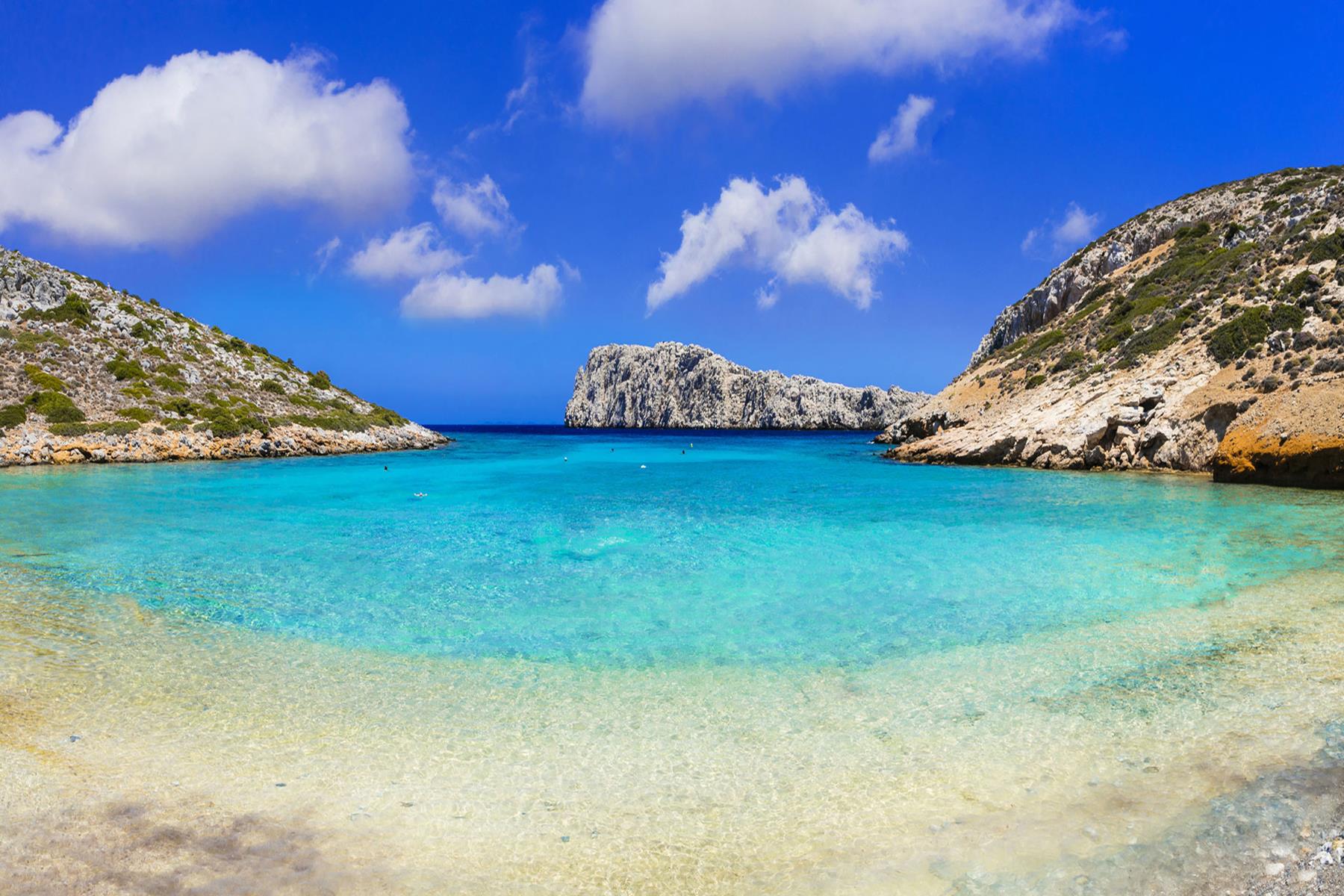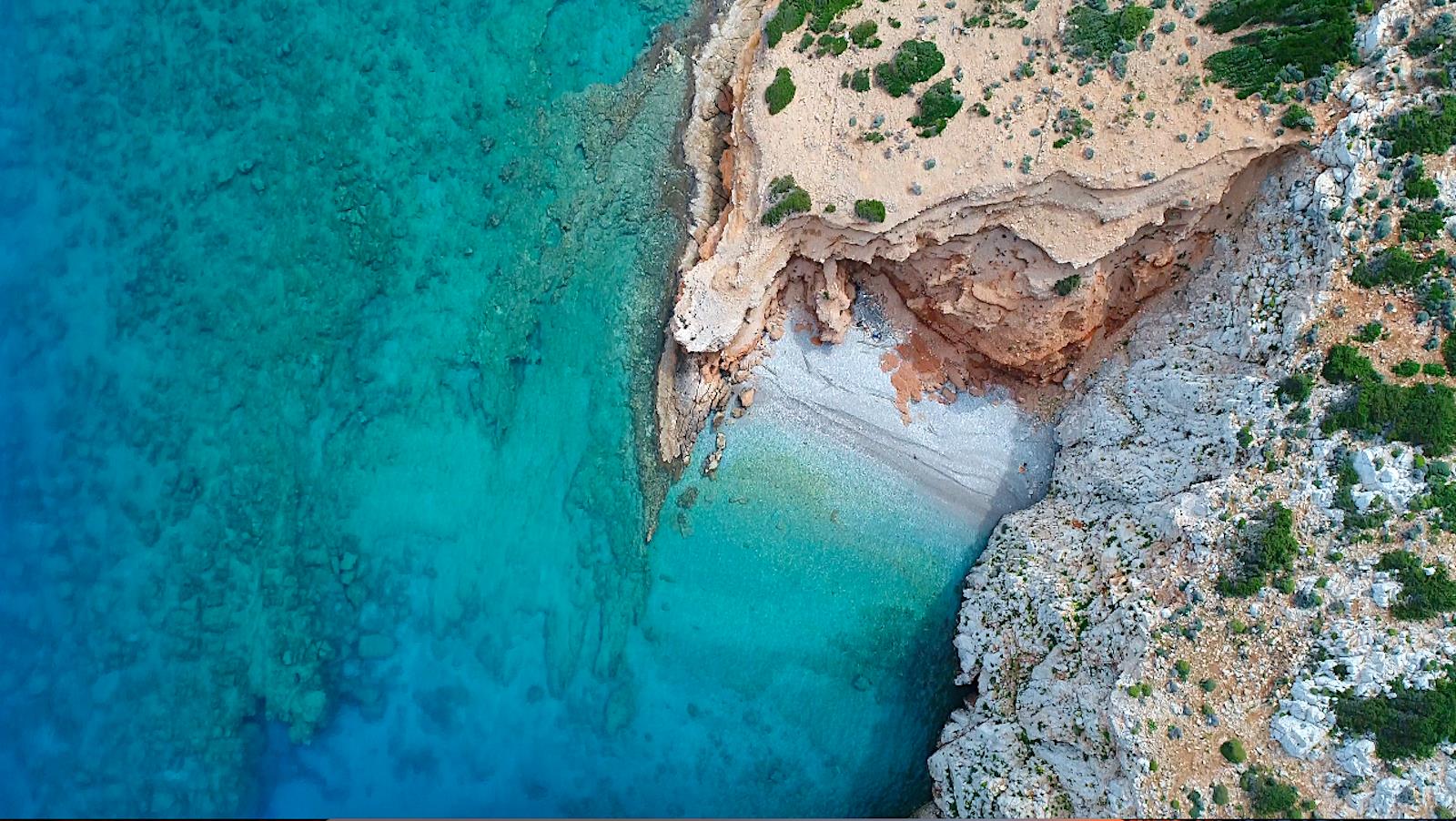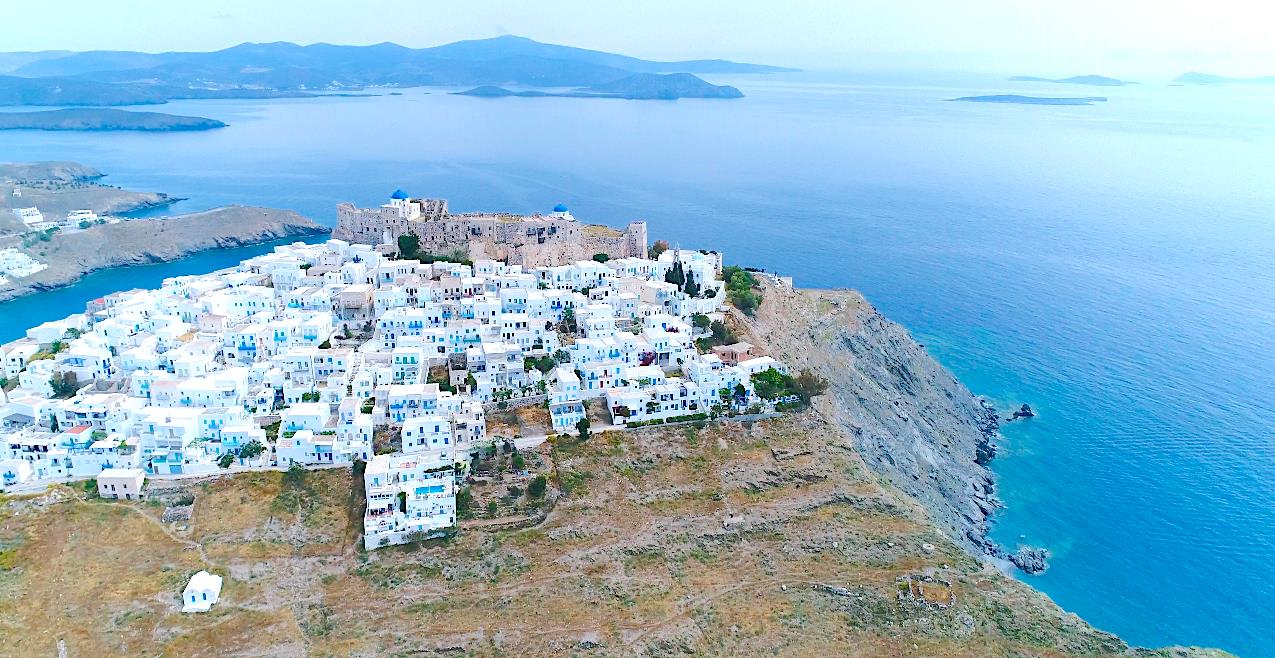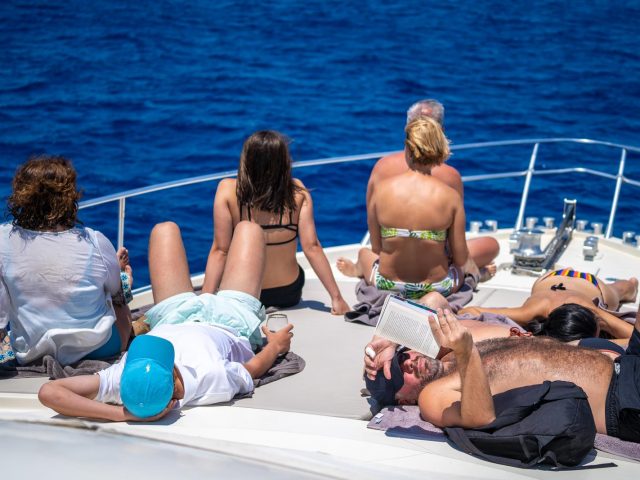Astypalaia
Astypalea the butterfly-shaped island located exactly where the Dodecanese
meets the Cyclades, with the bluer-than-blue seas, the crystalline waters
and the beautiful beaches is for any visitor a unique discovery.
Town: 0,5 km
Airport: 9 km
Port: 6 km
Photo Gallery

If you need ticket booking, please go to Ticket Booking and we will inform you regarding the availability and the cost of your tickets.
Boats from Piraeus-Athens to Astypalea
Schedule from 01/01/2019 to 14/06/2019
All the routes are running from Blue Star Ferries with vessels Blue Star Naxos and Blue Star Patmos
Departure from Piraeus

Schedule from 15/06/2019 to 01/09/2019
Departure from Piraeus

Schedule from 02/09/2019 to 31/10/2019
Departure from Piraeus

Boats from Astypalea to Piraeus-Athens
Schedule from 01/01/2018 to 14/06/2019
All the routes are running from Blue Star Ferries with vessels Blue Star Naxos and Blue Star Patmos
Departure from Astypalaia

Schedule from 15/06/2019 to 01/09/2019
All the routes are running from Blue Star Ferries with vessels Blue Star Naxos and Blue Star Patmos
Departure from Astypalaia

Schedule from 02/09/2018 to 31/10/2018
All the routes are running from Blue Star Ferries with vessels Blue Star Naxos and Blue Star Patmos
Departure from Astypalaia

Boats between Astypalea-Kalymnos-Kos-Nisyros-Tilos-Rhodes-Kasteloriso
Schedule from 01/01/2019 to 24/06/2019
Routes from Astypalaia to Kalymnos, Kos, Nisyros, Tilos, Rhodes and Kasteloriso

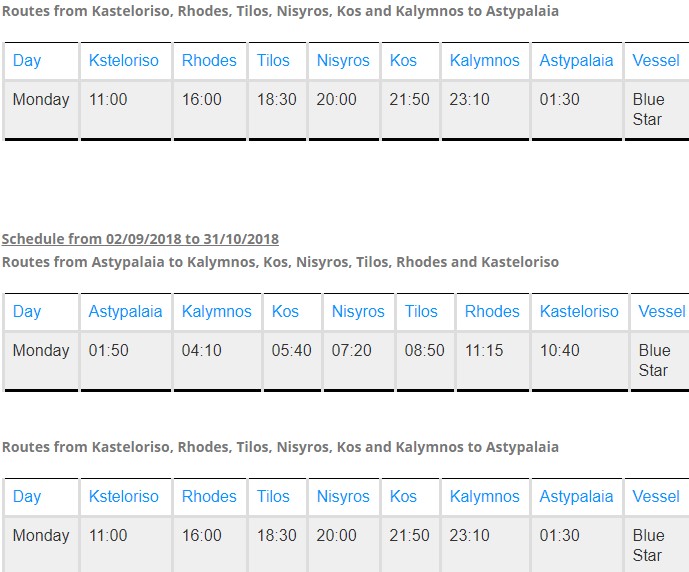

Flights between Athens – Astypalaia




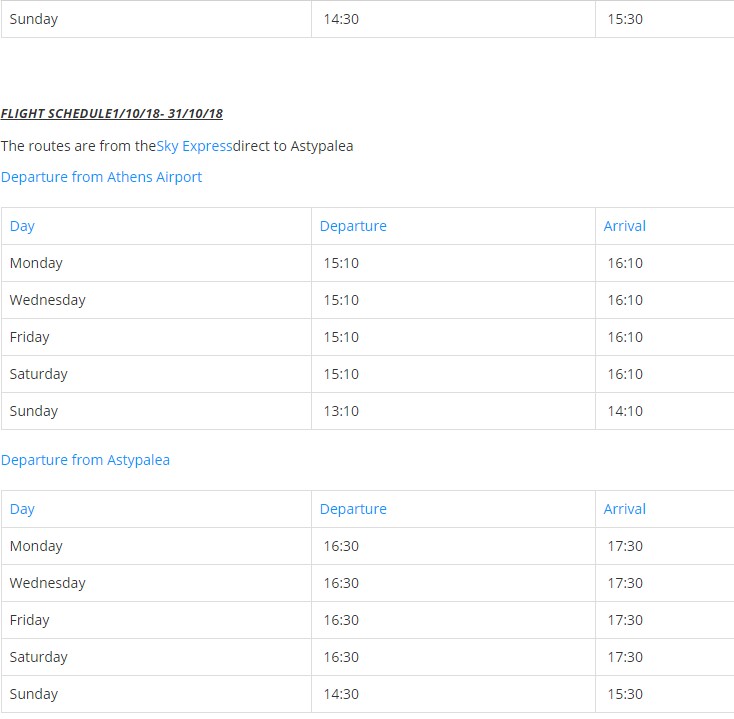
Flights between Astypalaia, Rhodes, Kos, Kalymnos & Leros


Astypalea or Hora
This is the capital and port of the island built on a hill protruding into the sea thus forming two bays: the port – Pera Yialos -and Livadi Bay. The peak is dominated by the fortress built of dark local stone from which one can see the glowing white domes of the Evangelistria and Aghios Georgios Churches sticking out. Around it are white houses with blue doors and windows and wooden railings on the balconies. Among them are churches and domed chapels. On the saddle of the hill are eight windmills, a unique jewel adorning Hora. Slightly further on is the traditional coffee house and further still is the Town Hall from whence the two main roads which lead up the hill to the Fortress begin. Each leads to a well known church, the Monastery of Panaghia Portaitissa on the Livadi Bay side and the Megali Panaghia Church on the Pera Yialos side.
Pera Gialos
The area of Pera Gialos is located at the heart of the capital and for many years was the main port of the island. At this time, is a very nice place to stay, especially for visitors who reach the island by their private boat, as it has a new marine.
Analipsi or Maltezana
A seaside village spread out along a small valley in Exo Nisi with a beautiful sandy beach. The second name ‘Maltezana’ makes reference to the pirates who pillaged the Aegean and found refuge in the island’s sheltered bays. The village hugs the bay with a long jetty at which fishing caiques moor. The orchards and vineyards go right down to the water’s edge. Tour boats can take visitors to the island’s beaches and the islets of Hondro, Ligno, Aghia Kyriaki, Koutsomytis, Syrna and Kounoupi.
Livadi
A seaside village spread along a fertile valley on the inlet of the bay with the same name. Livadi is the island’s flower garden. The gardens with mandarin trees, orange trees, vines, and houses bedecked in flowers are spread along the entire length of the stream which terminates at a beautiful beach.
Vathi
Vathi resembles are lagoon. The bay is almost completely closed off with an opening of just 50m. There are two small villages at Vathi: Exo Vathi which is at the mouth of the bay with its small jetty at which caiques moor and Mesa Vathi on the inlet of the bay with fields, a few trees and vineyards. Visitors can reach Vathi by road along a passable dirt track or by boat. There are regular sailings from Vai Bay.

Beaches
Livadi(organized): South, 1.5 km from the Chora (Area Livadi). The beach combines sand and pebbles. Along the beach there estaitoria, cafes and tourist shops.
Pera Gialos (organized): Southeast, 500m from the Chora (region Pera Gialos). Amphitheater of the beach there are cafes and restaurants.
Agios Vasilis: South, 1.7 km from the Chora (Region Livadi)
Tzanaki: Southeast, 2 km from the Chora (Region Tzanaki)
Pappu: Southeast, 4 km from the Chora (Area Pappus)
Agios Konstantinos (organized): Southeast, 6 km from the Chora (Region Ag.Konstantinou)
Vatses (organized): South, 7 km from the Chora (Region Vatses)
Kaminakia (organized): South, 12 km from the Chora (region Vatses)
Agios Ioannis: Southwest, 8 km from the town. Access by boat or 2 hours downhill.
Saint John the riser: South, access by boat.
The Beach Camping: South East, 2 km from the Chora (region Proto Marmari)
Trito Marmari: South, 2.8 mm (Area Trito Marmari)
Diaporia: South, 3 km from the Chora (Region Trito Marmari)
Mikro Steno: South, 6 km from the Chora (Region Steno)
Megalo Steno (organized): South, 6.3 km from the Chora (Region Steno)
Plakes: South, 7.5 km from the town (area Plakes)
Blue Harbour: South, 9 km from the Chora (Region Maltezana)
Matlezana beach (organized): South, 9 km from the Chora (Region Maltezana)
Schinontas (organized): South, 9.5 km from the Chora (Region Maltezana)
Karekli: South, 9.2 km from the Chora (Area Karekli)
Agrilidi: South, 11.3 km from the Chora (Region Agrilidi)
Psili Ammos: North, 12 km from the Chora (region Maltezana)
Panormos: North, 14 km from Chora (Panormos)
Koutsomitis: Island in the middle of the Aegean (accessible only by boat or excursion boats)
Kounoupes: Island in the middle of the Aegean (accessible only by boat or excursion boats)
Astypalea offers more countless beaches that are only accessible by boat.
You can rent a private speedboat or take a toor boat
You can rent a private speedboat at the beach of Livadi
You can board the Toor Boat from the port of Pera Gialos and the port of Maltezana.

Walk the streets of the traditional community
Maybe it’s the most beautiful and the shortest route you can do in the traditional village streets. A walk is enough to discover the interesting architecture of Astypalaia and enjoy the spectacular view of the sea.
Day trip to the islands Koutsomiti and Kounoupes
In order to reach these 2 islands you should rent a private boat or go with the excursion boat.
Approach by private boat: You need to go to Livadi beach in order to rent a private boat. By following the instructions ( gps included ) you will reach the islands in 20 minutes.
Approach by excursion boat: here all you have to do is to be at the port of Pera Gialos or Maltezana at the time you have been taught by the Captain.
Koutsomitis: It is a complex of two islands with green waters like those of a pool. A magical picture. You can go from one island to the other by swimming.
Kounoupes : it is quite a large island with a special feature that offers you a unique spectacle. The island consists of 2 parts which remain joined together thanks to a thin strip of pebbles and sand. This is a virgin beach that reflects people’s respect to nature. From the east side is formed a large and deep bay with crystal clear water, and from the west side communicates with the open sea. Enjoy…
Destination beach of Agios Ioannis
Beggining from the country by motorcycle, car or on foot (for hikers) heading northwest of the island we have the first stop at the Monastery of St. John, which is 8 km far from Chora. During the journey to the monastery, you will have the opportunity to photograph old stone houses, monuments and farms where different animals are reared. There you will get lucky to taste local virgin dairy products and the warm hospitality of the farmers. Continuing the route, you will often have the pleasure to enjoy the panoramic view that the high altitude gives you. Furthermore, you will be surprised from the top of the mountain where you can see Astypalaia surrounded by the sea. Arriving at the monastery, you should necessarily leave your car or motorcycle. At this point begins the descent to the beach. The route from the monastery to the beach will last 2 hours. Halfway there is a small waterfall (the famous waterfall of St. John), whose waters fall into a natural pool which is formed by the rocks of the mountain. Taking a refreshing dip you will get strength for the final part, the beach. Enjoy swimming.
Spilia tou Negrou (Cave)
This is a cave which is located in Vatses, in the western part of the island of Astypalaia and connected, according to tradition, with various myths about pirates and treasures. So, according to the prevailing myth, the cave owes its name to a pirate from Samos who acted in the Aegean Sea and once fled there likely to hide a treasure. This story is recorded in a book titled “George Negro – The tiger of the Aegean Sea” which lists the sources and the documents were used to support the existence of such a person. The cave has stalactites and stalagmites, and was used as a church of Christians who fled there to pray and hide during their persecutions. There are several ways to reach the cave, either by boat beggining from the town or getting to the beach of Vatses by car and then walk for about 45 minutes. You should be very careful the time you enter the cave!
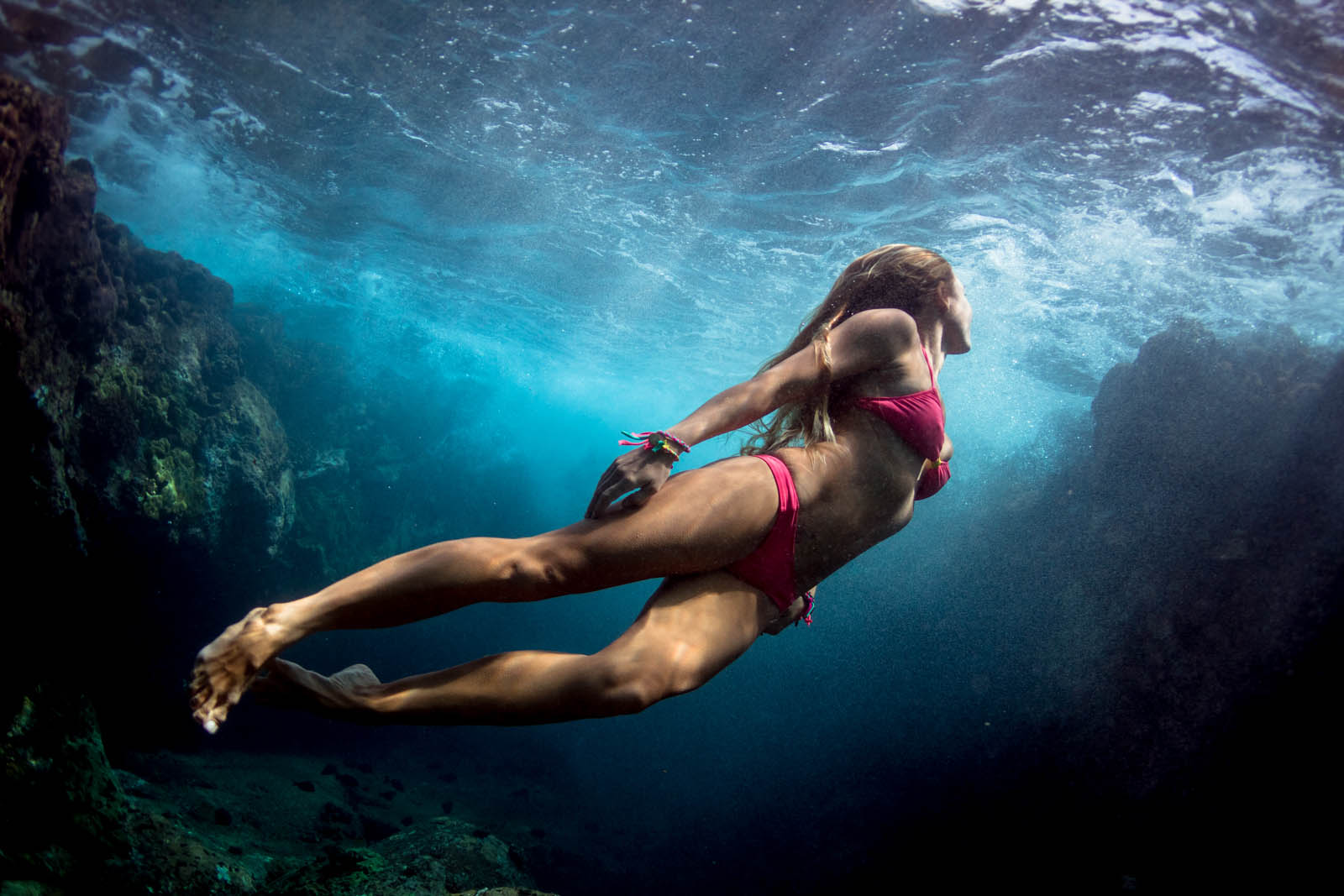
Astypalea as an ideal destination for alternative tourism offers a vast variety of choises and the chance to its visitors to take advantage of this variety that arouses from the exquisite geographic position and proper climate.
Now Astypalea has its own very appreciable climbing field, its own network of walking paths and two caverns maped and photographed. And all these next to the rich historical monuments. For those who will now visit Astypalea, particularly spring and autumn, it is sure that they will enjoy them.
Walking
Trekking in Astypalea is the ideal way, to explore the heart of this fascinating island, by walking either on engraved paths or ascending the highest peaks. Hiking in Astypalea gives you the chance to walk and to discover ancient paths walking through mythology and history. Each season gives magnificent colours and interests. We guide you off the beaten paths to meet the “authentic” Astypaleans and our traditions.
Outdoor Activities
If you are an outdoor adventurer, you like to be revitalized through Active holidays and various Outdoor Activities.
The climbing field “Ftera” is separated in two parts (because of the bas-relief of the area) and has been engraved 20 routes, equipped with stainless plugs M10 and with reles at their end. The rock is asbestolithic and generaly is good enough.
The field is easily accessible from Chora (20 min. by car). Then you will be excited to join our Astypalean Adventures in the nature and the history of Astypalea … the island of contrasts.
Rock Climbing
Rock Climbing in Astypalea means an extraordinary combination of holidays with this unique fun activity, which builds group spirit and self-confidence on mountain crags, beach cliffs and beautiful traverses right above the waters of the Aegean Sea!
Caving
Caves have always been a part of Greek Mythology and History, from the birth of Zeus, the Father of Gods, to the most recent European History.
Mountain Biking
With the gentle whir of our pedalling, we enjoy the spectacular views and smells of Astypalea’s countryside.
Water Sports
On the beach of Livali you could rent private boats or water bikes.

The other settlements which exist today were created in the uncultivated spots of the island.
The biggest of these settlements are Livadi and Analypsi or Maltezana, created during the Italian years. Most of the islands life is concentrated in Chora. It is built on a peninsula which is bathed by the serene sea creating two tranquil bays called Pera Yalos which is situated on the left as we look at the open sea and Livadi which is on the right. The Venetian Castle, with its two whitewashed churches, stands proudly at the top of the peninsula proclaiming the onset of the development of the settlement.
As the centuries progressed, little white houses began to appear outside the walls of the castle which covered the hill and reached the port of Pera Yalos joining together to form a mosaic of our islands history. The portrait of Chora with its white body and ocean blue heart, leaves the visitor speechless because of, its beauty and harmony.
The Castle takes up all the plateau at the top of the hill and used to be densely built group of houses which made up the Middle Ages settlement. Today, only a few of the houses have survived, the outside walls of which make up the walls of the Castle. Only on the southside is there a strong battle tower which is known by the name “Serai”. Inside the Castle, between the scattered columns and the carved stones, two beautiful churches, Panagia of Castro (the Holy Virgin of the Castle) and Agios Giorgios (Saint George) stand. The church of Panagia of Castro was built in 1853 on the arched entrance of the castle. Inside there is an ownership signature of 1413 and the shields of the Querini family. Agios Giorgios was built in 1790. Around the walls of the Castle the uniform white houses, with blue stutters and wooden balconies, the churches and all the small family temples are clustered together.
The balance of white and blue is cut of by the red shade of geraniums which blossom in the pots of the narrow, stone-cobbled lanes. In the old neighborhoods of Chora, there are no great-open spaces, no squares. The Astypalaian traditional houses are similar to those of the Cyclades.
Moreover, the cycladic colour seems as though it surpasses the dodecanese colour around the island. The most interesting part of the house other than the fireplace and the divisions of the walls, is the wooden loft in the far part of the room decorated with lace, woodwork, which was used as a bed. It has a height about two meters and to reach it, one must climb a ladder which is formed by three wooden trunks, one placed on top of the other. Next to the bed, three or four rows of carved, wooden shelves make up the “Krijola”, on which are kept the most beautiful and the best glassware of the housewife.
The wooden ornamentation of the bed, the Krijola, the door and window cases and the ceiling is a sample of the excellent wood-carving craftsmanship which developed in Astypalaia.
One of the most characteristic pieces of work of this art is the carved, wooden ceiling of one of the houses inside the castle; the only one which has been saved today.The special ornamentation of Chora is its eight preserved windmills along the turning of the hill from which the new houses (suitable to the surroundings) decline towards the port. Near the windmills, the traditional café of Chora is found and a bit further up is the Mayors office from where the two main roads begin their ascent towards the castle.
Each leads to a noteworthy church: the monastery of Panagia Portaitissa, which is on the side of Livadi, and the Megali Panagia, which is on the side of Pera Yalos.
Megali Panagia is formed by a group of five temples which, having a view of the sea, create a unique picture. The special feature of this church is its cobble-stoned courtyard. Panagia Portaitissa makes up the religious center of the island with the largest amount of homage. It began being built in 1762 by the blind Osios Anthimos from Cephalonia who before building Panagia Portaitissa, has built the monasteries of Zoouthochou Pigis at Sikinos and Saint George at Castellorizo . The construction of the church lasted nine years during which the tradition has it that many miracles occurred. It is dedicated to Panagia Portaitissa of the monastery Iviron, a copy of whose icon Osios Anthimos brought to Astypalaia. On the 15th August when the celebration of Portaitissa is held, there is a grand festival with violins and utes. Near the monastery the ecclesiastic museum of Astypalaia is on display with rare heirlooms of unique craftsmanship.
The rippled coastline of Astypalaia is nothing more than a constant game between the land and the sea. In about the middle of the island, the land narrows so much that a strip of land, only 100 meters in width, connects the two parts.
Steno, as the local townspeople refer to it, divides Astypalaia into the eastern part known as the “Inner Island” and the western part known as the “Outer Island”. The concrete road towards the “Inner Island” stretches past the successive beaches “Marmaria”, “Steno”, “Plakis” and the “Blue Limanaki” until it reaches Analypsi or Maltezana after a total of 9 Km. Just a little before the town, a fork in the road leads to the airport of the island (10 Kilometers from Chora). Analypsi is one of the three towns of Astypalaia. It is also called “Maltezana” because it was first settled by Maltese pirates.
The town, which is usually made up of mainly summer holiday visitors, embraces the bay with its long dock where fishing boats come round and includes the orchards and vineyards of ascends through the steep mountains of this side of the island, offering a panoramic view of Vai bay, and ends up at the closed bay of Vathi.
At the serene site of Mesa Vathi, a beautiful church, a tavern, a few houses, and a few fishing boats at the small dock can be seen. The visitor can reach Vathi either from the passable dirt road or by the boat which conducts frequent trips from Vai. Vai can be reached by the bus which leaves from Chora.
Before the road to Vathi begins, a difficult dirt road ends up at the monastery of Panagia Poulariani.
Returning to the “Outer Island” and after Steno, a dirt road begins which leads to the small port of San Andreas (1 Kilometer) where a small tavern can be found.
Another route from Chora runs through the mountains of the Inner Island whose curves are smooth.
The panoramic views of Chora and Livadi at the outset and the view of the tranquil mountains with the scattered, white monasteries offers a unique pleasure to the viewer. On this same route is the monastery of Flevariotissa.
Since the monastery of Flevariotissa’s festival is celebrated on the 2nd February, it is the winter rendezvous of Astypalaias friends from all over the world. This route comes to an end in the area called Agios Ioannis (Saint John) which is 16 kilometers away. The picturesque, whitewashed church is set between two abrupt hill slopes near the open sea.
In front of the church, on the hill, there are orchards and bubbling water sources and, further down, after quite a bit of walking, there is a superb beach.
On the right of the church, high on the edge of the mountain, there are the remains of the old castle.
Near Chora is the village of Livadi which is the blossoming garden of the island.
The orchards, which are overflowing with tangerine trees and orange trees, the vineyards, which are seething with their juicy grapes, and the houses which are surrounded by numerous, multi-colored flowers, stretch throughout the ravine and wind up at the beautiful beach. From Livadi, a passable dirt road begins which provides a truly breathtaking view of Chora and connects Tzanakis, the cut off nudist beach, to Chora; and, after passing a number of small coves and Papou beach, it ends up at the enticing, sandy beach of Agios Konstantinos.
Two of the most beautiful beaches of the island can be reached by the tourist boats which set off from Pera Yalos and Maltezana. These beaches are Kaminakia, where there is a tavern which serves boiled goat (stew), an island speciality, and Vatses, where there is a cave with stalactites and stalagmites.

Cultural Events
For yet another year, the Festival Astypalaias “Maxoulia 2012” gives an indication of the involvement of the Cultural Association of Astypalaia..
The Culture of Astypalaia gives this summer the present, through a series of events included in the festival Astypalaia. For the twelfth consecutive year, the beautiful island of the Dodecanese hosts cultural events targeting to the permanent residents and to the summer visitors of the island that have been embraced with great fervor the Festival.
The artistic direction belongs to the renowned composer Giorgos Andreou, while the last summer an active participant and Cultural Association Astypalaias with the “Maxoulia” of a series of activities that include theater, music and visual arts, all built on the idea of self-organization, volunteering and Aid amateur and youth initiatives.
The festival is held under the auspices of the Municipality Astypalaias.
Note from the volunteer artistic director of the Astypalaias Festival , Giorgos Andreou:
“In Astypalea continue the effort. Twelve years on an island in the middle of the Aegean, we honor the culture of good Greek Song and participate in the nationwide cultural map with Astypalaias Festival, an institution with nationwide recognition and acceptance. From the summer of 2011, supporter and collaborator is our Cultural Association Astypalaias with “Maxoulia” of a series of activities that include theater, music and visual arts, all built on the idea of self-organization, volunteerism and support of amateur and youth initiatives. The effort continues and this year (2013) with excellent results – the visitor Astypalaias has to choose from a series of concerts, theatrical performances and artistic events, so with the holidays to sing, be moved to reflect. It is worth mentioning that this year’s celebration of the cultural events in Astypalea is dedicated to the memory of the late Mayor Tassos Aliferis Tilos, an important man of local government in the Dodecanese, with important and diverse work and many valuable initiatives in the field of Culture. ”
Visual Arts
Every summer in the beautiful square of the Windmills is organized:
Book Fair
Handmade Jewelery exhibition
Painting exhibition
Photo-Gallery exhibition

Customs and lore
In addition to reviving all the local religious feast day celebrations, a characteristic example of the preservation of local customs is the traditional wedding on Astypalea. This begins with the bridal bed being strewn when relatives and friends of the couple and the whole island call at the bride-to-be’s house with gifts, food and the bed is decked with money and rice to that the couple can lay down firm roots. Fun is had until the morning with food and wine being served and the celebrations end on the wedding day when the bride and groom are accompanied to the church by local musicians on the violin and lute who sing praises to the newly weds to a traditional air from Astypalea.
Folklore feasts and Celebrations
On 2nd February the feast of Panaghia Flevariotissa is the main winter gathering of the people of Astypalea. It is when they congregate to celebrate with traditional dances, food and abundant supplies of wine.
The largest feast on the island takes place on 15th August in honour of Panaghia Portaitissa lasting from 14th – 16th August. On the first evening, on the eve of the feast, following vespers there is a celebration in the grounds of the church. On the feast day itself outside the church stuffed lamb known as ‘lambrianos’ is usually cooked. All visitors and friends of the island are invited and the costs are paid by the Municipality.
On the following day sporting events take place held by the Municipality and the Cultural Association. These games known as the “Koukania” include swimming, a game where blindfolded competitors feed each other yoghurt and ‘petino’ where a false cockerel is tied to the end of a wooden pole smeared with grease. The aim of the game is to see who can reach the cock first walking over the grease.
On 4th September the icon of the Virgin Portaitissa and the remains of Blessed Anthimos are paraded around Hora terminating outside the Town Hall. Following this they are carried to the house of those celebrating their name day where the house is then blessed. A party follows.
On 8th September Panaghia Thomiani is celebrated at Vathy where food and wine is served up. This is followed by traditional dancing. Panaghia Poulariani is celebrated on 8th September and Aghios Dimitrios on 26th October.
Aghios Panteleimon is celebrated on 27th July and Christ the Saviour on 6th August with traditional sweet being prepared.

Traditional Meals
“Rantista” (lentils cooked with finely grained dough and vinegar)
Stuffed vine, cabbage leaves or courgette flowers
Liver finely chopped and cooked with spices known as ‘lambrianos”
Traditional Recipes
1. Pougia
Materials:
For the dough:
½ kg flour, 3 tablespoon oil, 1 teaspoon salt, 1 egg, the juice of one lemon, some water
Savory stuffing:
Kopanisti, 1 egg, some water, a little mint
Sweet stuffing:
Green, a little cinamon, a little sugar, a little milk
Execution:
puggiaPlace in a bowl of dough materials, from solid to liquid and knead to make soft dough (not too tight). Cut it into small balls which roll then pressing to make pita bread round.
Place the filling of your choice on one side of the circle without stretching it to reach the edges. Then fold the pita bread and press the edges of the dough to close and pinch the dough in the chamber to make sure that they will not leave the filling while it’s fried.
Throw them in the pan in hot oil to cook. We turn to brown and just pull them out by placing them on absorbent paper.
The fresh pouches sprinkle with honey and cinnamon.
2. Yellow cookies
Materials:
10 kg flour, Fresh yeast (such that n ‘corresponds to 10 kg flour), 1 ½ pound butter margarine, 3 green, 2 liters of milk, 2 grams saffron (crushed and dialymmeni in milk), Salt, Pepper
Execution:
Knead very well all the ingredients, starting with solids and slowly add the liquid.
Shape cookies by sticks and unite to make a circle the size of a dish of coffee. Place them in towels and wait for the dough to raise. Once baked in puff built oven.
Since cook waiting to cool. Should be put back in oven to get the nut form, except that the oven has a built-off. The fire of the coal will cook the yellow cookies for several hours.
To understand that it is ready, we put one of them near our ear and press it. If the sound meets the feel of soft broken nut, then the yellow cookies are ready. When cooled, put in large cans and close immediately to preserve them for some time.
Gourmet Traditional Products
“Poungia” (cheese pie made from kopanisti cheese and honey)
Preserved fruits (quince, fig, bitter orange, bergamot orange)
turnovers
Various local cheeses such as “ladotyri”, “myzithra”, “chlori”
A type of yoghurt called “xyalina”
Yellow bread rolls “kitrinokouloura” with ‘chlori’
cheese and saffron and pies known as ‘lambropittes”
and the exceptional “honey of Astypalea” smelling thyme and amazing taste

Astypalean Town Hall 22430 61408
Astypalean Port 22430 61208
Astypalean Police Department 22430 61206
Travel Information 22430 61412
Astypalean Airport 22430 61665
Olympic Air 21035 50500
Blue Star Ferries 21089 19800
Local Blue Star Ferries Agency 22430 61224
Emporiki Bank (Astypalea Branch) 22430 59890
Medical Center 22430 61222
Pharmacy 22430 61444
Post Office 22430 61223
Customs Office 22430 61317






